Renaissance Man (part 2 of 2)
The Director of Aviation Facilities for Howard Hughes, was a mobbed-up Italian Count and CIA Central Africa frontman who piloted the 1960's counter-culture land art movement for famous artists, including Michael Heizer and Walter de Maria.
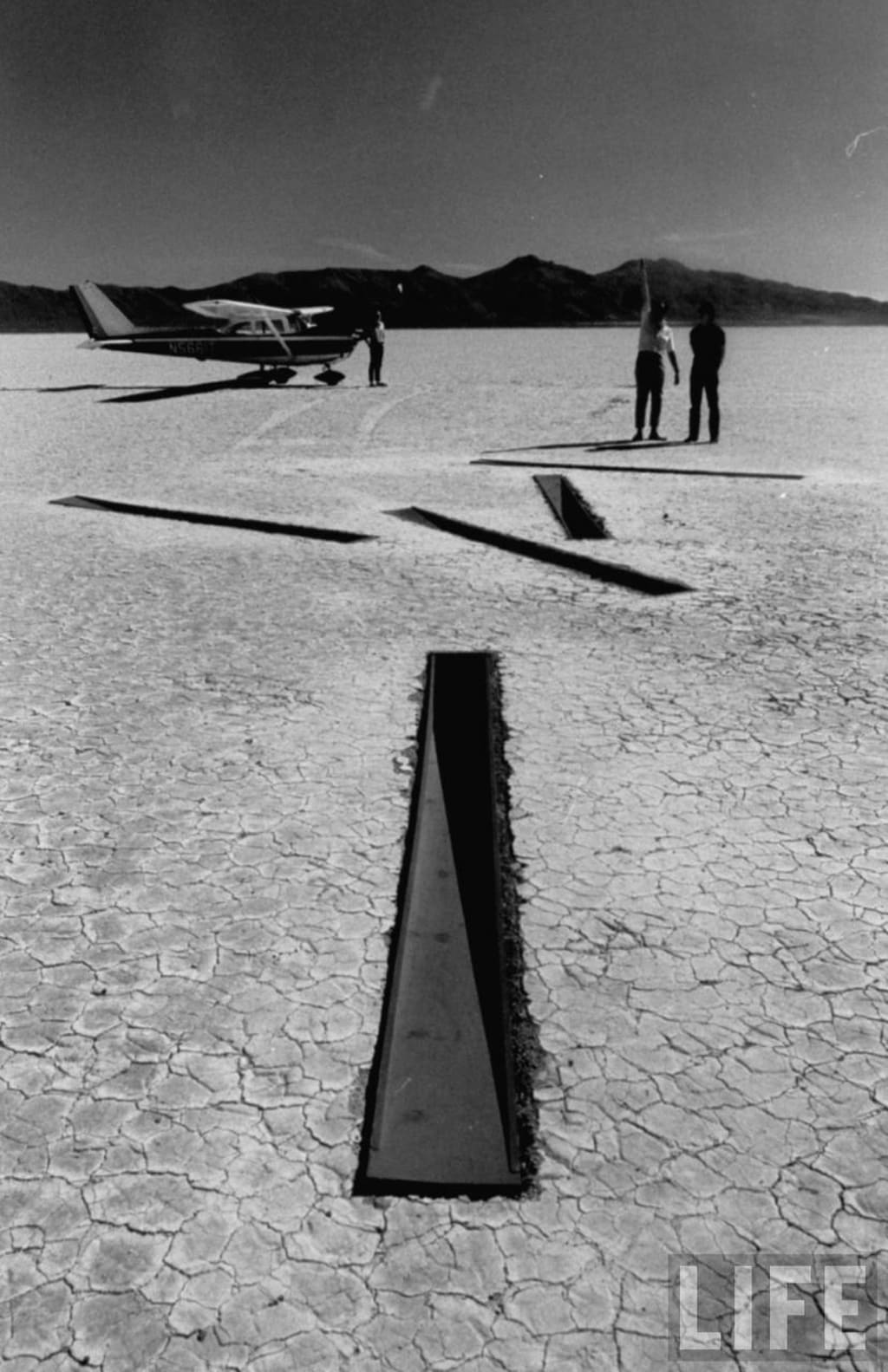
Continued from Part 1
Heizer has managed his career extremely well. Besides his large earth works, He has continued his dialogue with a series of drawings, print issues and smaller sculptures made in his shop and studio at The City in Nevada. He is prolific and well received. The sale of these smaller works supports his basic operating and living expenses. DIA Foundation has provided the funds for the construction of The City and probably has now taken on ownership.
Heizer fabricates his own pieces. He is a talented metal worker and a skilled heavy equipment operator. He is as adept working with natural materials as he is with exotic compounds.
He was afflicted starting in the late 80’s with a vague weakness in his limbs that progressed to a painful paralysis that became so critical that Jennifer and Mary called me at 2 AM in the morning on radio phone and I had him flown out of the valley by helicopter air ambulance.
As a result of an incorrect diagnosis by my own internist, Heizer almost died. He was flown to Sloan Kettering Institute in New York where specialists found he had severe polyneuropathy. A crippling affliction of the nerves. Michael has had a tough battle with this extremely debilitating illness, which I think may have resulted from his exposure to heavy metals and toxic gases when plasma arc welding, or etching and coating his metal works. He has recovered the use of his limbs, but has to wear a brace on one hand.
Heizer has an indomitable spirit and hasn’t let his infirmities slow him down in the least.
Over the years Heizer’s characteristic, almost paranoid, reclusiveness needed to be supported and I was tasked with providing security services and access control to his Garden Valley location. If he were disturbed by anyone he would call me by radio telephone to see that it didn’t happen again.
He famously has turned away media and solicitors, some traveling all the way from the Continent, many right at the entrance gate to The City.
For years I have accompanied and guided people having business with Heizer to the Garden Valley location. Most, especially the Europeans, would never have found the way.
Steel barrier gates two miles from the work prevent ground access. Signs warning against trespass are legally posted.
Any aircraft flying low over his location would cause him to notify me with the registration number so I could make an inquiry, or complaint with the FAA.
The local Nevadans are for the most part small ranchers, sheepherders and miners. When we first started activities in Garden Valley I realized that labor and supplies had to come out of the tiny Hiko/Alamo community dozens of miles to the south of Garden valley.
Heizer was an unknown and perceived by locals as an East Coast hippy liberal threat. His activities were not understood and suspect. Even though He didn’t look like a city artist, the rumors were getting a bit ugly. We had to win them over and the best way to do that was to come clean about who Mike was and wanted to do. Get them enthused with this new art deal and the possibility of making some money.
I had Mike make up a series of slides of his work, and I added some of my own from trips to galleries and museums to create a slide presentation demonstrating an exposition of art and a time line. We made up a book of art images showing a simple historic progression to pass around.
Contacting the County Commissioners and the local Mormon Bishop, I asked for and received an enthusiastic approval to have a town meeting in Alamo using the new high school gym. Most of the older inhabitants remembered me as the boy form Las Vegas who had lived on the Buckhorn Ranch and rode a horse to the large tin roofed one room school house.
Dad, mom and the kids showed up. The place was packed. Several hundred souls. I gave a short talk on art appreciation with an emphasis on art as a communicator of ideas. I explained how Michael’s art was the cutting edge of this form of communication and why it was important that his work be in Nevada. They got it.
From that night on we were totally accepted and the relationship with the locals has blossomed over the years, being well oiled by employment and purchases.
Today, the citizens of Alamo, Hiko, Caliente and Ely refer to Michael Heizer as “our artist” and they know more about minimalist and conceptual art than your average New York gallery hound.
By 1979, Joan and I had five children. I had gone back into the casinos as a Shift Boss for Shelby and Claudine Williams at the Holiday Casino on the Strip.
I continued part time work with Heizer and less so with De Maria. The last work Walter had me do after location studies and cost analysis for both Lightning Field and Munich Mountain were a couple of exploratory ground trips to some possible sites in Central Nevada and Arizona.
Early in our relationship, I had become aware that De Maria had tried to stake a claim to Nevada and was following Heizer’s lead. Heizer eventually won Nevada and my loyalty.
Walter finally elected to do the full version of Lightning Field in New Mexico because of the desires of those sponsoring him and I’m sure because my studies had showed that there was more cloud to ground lightning activity in that area. And it was far away from Michael’s Nevada earthworks. I donated my original of the feasibility study to the Deiro Collection at the Center for Art + Environment at the NMA.
My work with Heizer slowly wound down through the 80’s and 90’s. I began to take on only what couldn’t be done by others. I was now more, or less, a friend and an errand boy.
The days of making art, drinking, riding horses, shooting guns and whatever were a memory. I had a family now and a successful business that took almost all my time and also put me all over the map. I made millions in the ten years between 1980 and 1990.
In the 80’s, on an extended road trip to Wyoming with Michael to look for large rock masses, I photographed, in black and white, dozens of birds and animals that had been flattened by traffic. The piece was to be called Road Kill. Michael has my photos but hasn’t published them.
We made an expedition with Maris, a photographer friend of Michaels, to Sonora, Mexico and Ramona, California to photograph large free standing granite masses that I had located from the air. Those photos were exhibited and for a first time I was portrayed in a work of art. I was flattered.
Heizer and Dia Foundation’s, Michael Govan, had me contact any land owners I could find at the periphery of Garden Valley and arrange to acquire their properties.
In the late 1990’s, I negotiated DIA’s last purchase of a ranch that was on the periphery of Garden Valley and therefore an issue with Heizer’s desire to keep people away. This left him in control of everything within sight in that enormous valley and the surrounding foothills.
This engagement as a consultant and broker for Dia also involved the acquisition of water and mineral rights in the peripheral areas of the City’s location.
I made the occasional run up to see Mike, usually bringing a care package with his favorite wines and cigars. He and the girls have a large garden and raise sheep and Beefalo.
I continued to guide VIP’s and approved media to The Double Negative and The City at his request.
He usually invited Joan and I to attend his art openings. We were at the installation of the Perforated Object pieces in Reno and Ace Gallery’s opening with Michael’s large stone works in New York.
Artist Charles Ross retained me to do an air and ground location search and feasibility study, including photography, for his proposed piece Solar Center to be made in Utah.
One accomplishment that impacted the future of Heizer’s work in Garden Valley and other rural Nevadans was my success in getting Michael Turnipseed, the Nevada State Engineer, to grant approximately 100 acre feet of water rights to Heizer in front of the preferential filings of the Southern Nevada Water Authority and the National Park Service. Doing this set a precedent for other small ranchers to get water rights.
I had been appointed to the State Advisory Board for Ground Water Management; the state officials that I had been pestering figured if you can’t beat him, than make him a member of the club.
Michael and Dias ability to operate a commercial art production facility and engage in growing alfalfa for his modest livestock operation, garden and orchard depend on this water use authorization. The rights to the use of water, from where it is diverted, to what use, and in what quantity, is strictly regulated in Nevada where it is more valuable than gold and silver. The main importance of getting this allocation of water was that without it there would be no “City”. No water…no art work.
My work with the artists and the organizations I have mentioned has been well publicized. Some of the more recent media describing my contributions are “Land Art’s Handler” by Alicia Guzman and “Art and Aviation” by Brad Bynum
In the late 80’s, my Italian relatives, with whom I had no previous contact and who had been searching for me using only a Nevada birth certificate, found me. My minor celebrity had been seen and they soon wrote to me explaining I was an Italian Count (first born son, etc. It’s a long story) and needed to accept certain responsibilities.
Joan and I traveled to Italy and got involved with overseas family business and charitable work. As a result of several years engaged in helping others less fortunate, I was knighted (Now I was truly Joan’s knight in shining armor) and over the years rose through the ranks to be appointed Grand Chancellor of the Sovereign Dynastic Order of St. John - Knights of Malta. There are many Orders of St. John. I was knighted again in 1985, this time in the German Military Order of St. George.
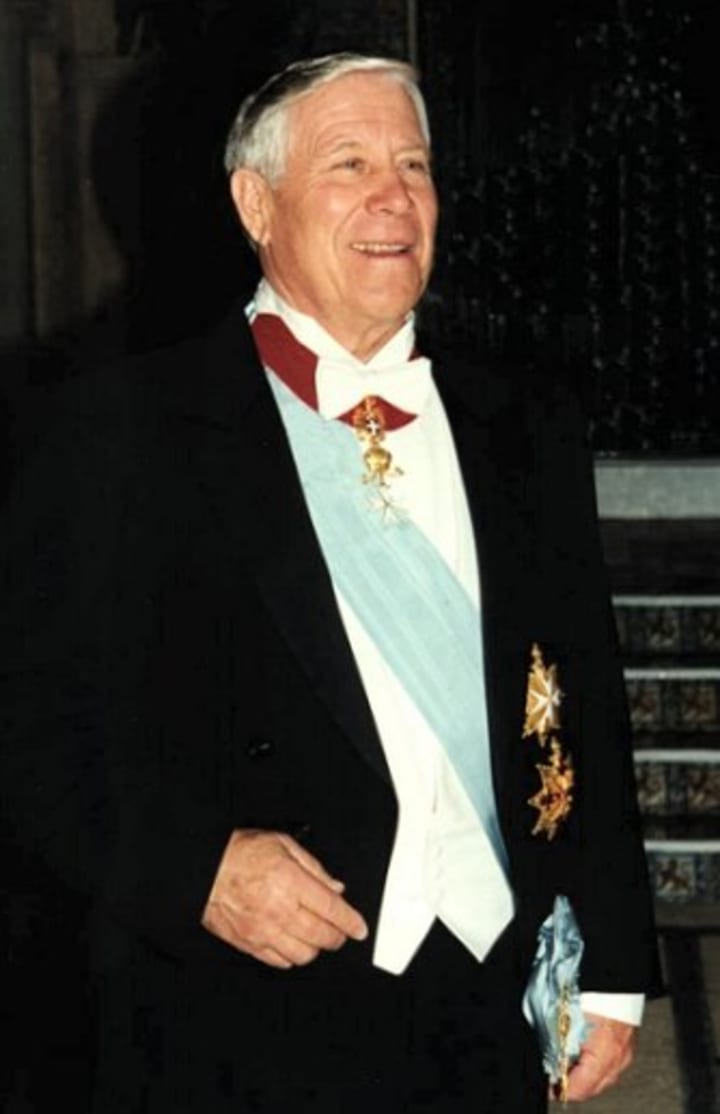
In a ceremony held in the Pantheon in Rome I was inducted into the Guardia d’Honore of Italy and took my rightful place in the House of Savoy as a true Royalist. During the ceremony I never forgot that this was happening to a Las Vegas High School graduate who used to be a card dealer on the Strip and dabbled in making art on the side.
Capitalizing on my wealth and new found friends and higher social position, Joan and I organized white tie charity galas in Las Vegas, Beverly Hills and Miami to benefit International Refugee Relief, the International Piano Competition held in Fliegler Hall in Palm Beach and the Flying Hospital in Africa.
My earlier work in Africa had left me promising myself that someday I would help to do something to alleviate the suffering of native people. The Flying Hospital is a DC-10 equipped with doctors and equipment capable of treating the sick and injured in remote areas.
I also organized galas for International Red Cross and Refugee Relief in China, Japan, Italy, Malta and Greece.
While working with Heizer and De Maria in the late 1970’s, I had started Robert Deiro & Associates, a Real Estate Auction Company. It was successful; we got lucky and sold a couple of hotels/casinos. It was the business that established my reputation and prosperity.
1992 rolled around and I took early retirement selling the family business to my son, Guy Robert Deiro.
Joan and I established the Lost Arrow Ranch in Pine Valley, Utah which we later sold; because it was boring!
In 1996, we built Villa Kismet, our present residence, at the Gilcrease Farm and Orchard in Northwest Las Vegas.
Our residence is named after my father’s Broadway hit musical “Kismet”. We have tried to make it as authentically Italian as we can. Joan is an artist in her own right and she designed the villa and did all the faux finishes and period decorating. It has been depicted in several publications and is photographed by passerby. Sort of an art work.
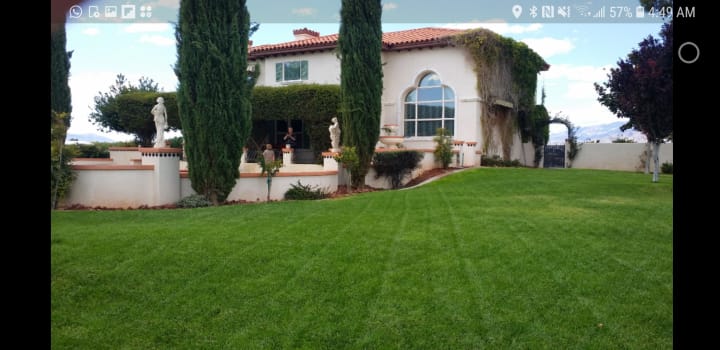
Joan keeps busy quilting, painting, doll making, playing golf and being a mother to our five children, twelve grandchildren, three great grandchildren and me. She is a gourmet cook and has written a book. Quite an accomplished and talented, loving, lady.
I had been a sport fencer most of my life, so in 1997 I started competitive fencing again and I obtained FAI and NCAA, International Fencing Master’s and Referee’s credentials and organized fencing programs at Community College of Southern Nevada, The Nevada Ballet Theatre, and the Adelson Academy of Excellence. I served a term as Director of the Nevada Division.
Jackie Bascow, a casting agent, had been getting me acting work in a number of small screen series that filmed in las Vegas (Vegas, Crime Story, Hearts are Wild, BBC’s Dark Star and BBC Scotland’s special on the Accordion).
I had joined the Screen Actors Guild while in California in the early 70’s and appeared in speaking rolls in I Spy, Mission Impossible and some others, best forgotten. I had done this mostly for poops and giggles. I continue to this day to appear in PSA’s and commercials. Again, for the fun of it. But, I take the money!
By 2000, Joan and I were still active in the community, but beginning to get long in the tooth. I would take my Jeep Cherokee, or a private plane, and go see Mike and Mary once in a while, or we’d phone each other, but it could be a year between phone calls. One stint of a half dozen years flew bye without any meaningful contact with each other.
My life’s other pursuits became more demanding and left little time for my avocation with modern art and its proponents. Mike and I drifted apart.
As the Grand Hospitaller of the Order of St, John, I organized the 2000 Millennial International Gala and Conference at the Paris Hotel in Las Vegas attended by several hundred members of the Orders of St. John and St. George benefitting Marlo Thomas’ St. Jude’s Children’s Hospital.
In 2002 the University of Nevada published my oral history entitled My Varied Careers and Rewarding Life in Las Vegas by Count Guido Roberto Deiro. It is out of print and I have begun to correct some errata and update it.
In 2004, and retired from all business, I graduated from a twelve week Citizen’s Police Academy program and became a Metropolitan Police Volunteer securing homicide and fatal accident crime scenes to release uniform officers to do more important work.
I attended the Nevada State Attorney General’s courses to be certified to teach seminars on Identity Theft and Elder Abuse Prevention. I also taught Refuse to be a Victim Courses to seniors and community groups.
For many years I had been a Certified NRA Home Firearm Safety, Armed Personal Protection and Pistol Instructor.
Until recently, I taught a twice weekly Firearm Safety and Armed Personal Protection Course for Women through a UNLV sponsored continuing education program.
I have been very fortunate to have had the ability to pay a little back to the city and state that have made it possible for Joan and I to have a full and interesting life.
My politician friends have seen fit to recognize me with some tributes.
The Las Vegas City Council named me Citizen of the Month recognizing my two years of service as Foreman of the Clark County Grand Jury.
The Clark County Commissioners honored my 40 years of community service by having the entrance road to Summerlin South and The Lakes named Count Deiro Drive.
Governor Kenny Guinn, in recognition of my contributions to those in need, signed a proclamation declaring December 29th as a day in honor of “Count Guido Deiro”.
In August of 2015, the United States Department of Transportation and the Federal Aviation Administration awarded me the “Orville and Wilbur Wright Master Pilot Award”. The honor is given to those aviators who have distinguished themselves in the field of aviation for over fifty years.
I had previously been awarded the FAA’s “Gold Seal Flight Instructor Award” for excellence in flight training and promoting aviation safety.
By now, a reader of this treatise may be wondering if my self-aggrandizement has a limit. It does, but I have done everything I’ve said I did… and I’m proud of it.
Recently, I received some news that I might not have many years left to keep having fun as I expected. I’m 80. So, I have made sure that I accomplished three things on my bucket list.
First, that my father’s memorabilia, recordings, compositions and musical instruments be safely curated and made available for study in The Deiro Archive at the Graduate Center of City University of New York.
Second, an award winning illustrated website guidodeiro.org dedicated to recognizing my father’s contributions to music as a composer and twenty year Vaudeville headliner, as well as revealing his long association with and marriage to the performer, Mae West, was created.
Third, that the materials accumulated by me during my long association with Michael Heizer and the late Walter De Maria documenting some of the history and importance of Earth Sculpture be archived in the Nevada Museum of Art and the Center for Art + Environment; The Deiro Collection.
This last item the donation of my ephemera and memorabilia and art works given me by Heizer and De Maria, was not met with happiness by Michael. He blew up at what he thought was a betrayal. His adamant and career long desire to control how the world should see and hear of him had been threatened.
Heizer envisioned I had shared confidences and private correspondence. I tried to assure him that I had not and that I was his staunchest friend and supporter.
We spoke briefly on the phone a few months after I had completed the distribution and donation to the Center for Art + Environment. Michael sounded rushed, and as eccentric artists acting like ingrates aren’t on my list of people I have to mollify, I didn’t stay on the line long and we finished with Michael saying we should talk further. I haven’t made that possible. Neither has he. Pity.
From time to time, I am engaged by professors teaching art classes at USC and UCLA to act as a docent when they arrange to bring their graduate students to see Double Negative, or Las Vegas Piece, or Jean Dry Lake.
In 2012, Nevada’s Governor Sandoval appointed me to a three year term on the Board of Directors of the Nevada Art Council, the body that directs the distribution of the National Endowment of the Arts monies. I quit after a year.
The forty year reigning Administrator’s idea of art was Indian baskets, cowboy poetry and finger painting. She and the other State employees tasked with promoting art to Nevadans did not seem to realize, as of this writing, the importance to Nevada that Burning Man has become.
Seventy Thousand people out on the Black Rock Desert building modern art. Did the works of Tingley and Heizer and De Maria contribute to that?
In 2012, Art Production Fund out of New York, in association with the Nevada Museum of Art in Reno, retained me to be the Project Manager for artist, Ugo Rondinone’s, desert piece entitled Seven Magic Mountains.
Paid for a change, I site located, did a materials and labor cost analysis, made notifications and started government regulatory compliance and interviewed and selected a prime contractor. The timeline for the piece was for it to be installed for a bi-annual conclave of the Center for Art + Environment in eighteen months.
Ugo Rondinone and Ann Wolfe of the Nevada Museum of Art, approved the site I submitted overlooking Jean Dry Lake that had obvious historical connections with previous works by Tingley and Heizer. Our meeting on the site was Ugo’s first look at the Mohave Desert and he was visibly taken aback. First time observers always have a hard time with scale.
Ugo had never fired a firearm, nor been in the desert before, so I had an enjoyable time introducing him to both. It turns out he is a natural marksman.
Finished with my work on Seven Magic Mountains according to contract, I sat back and watched with interest as the art work’s design changed radically, but the site remained the same, except the installation was to be made over one hundred yards of desert instead of the mile length initially accepted by Rondinone. Curious indeed.
I began to wonder if a set of photos, that I had taken after I had completed my initial work, had influenced the change from Ugo’s original proposed statement.
Rondinone’s first design was to be seven mounds of crushed rock, each with a base diameter of 100’ and painted in the weather and fade resistant pastel colors of the rainbow that he favors. It would be installed irregularly along a one mile path paralleling the I-15 freeway from LA to Vegas. Nearly sixty thousand cars travel this road daily.
The photos I had sent to Bill Fox, the Director of the Center for Art + Environment at NMA, were of six large triangular steel, government sponsored, decorative art works installed to ornament a freeway that connected to the I-15 freeway passing Rondinone’s proposed site.
I euphemistically labeled the photos “Six Magic Mountains” as the resemblance to Ugo’s mounds was unmistakable.
The finished piece, which debuted in December of 2015 to a mixed reception from the great unwashed; they having circulated a petition to have it removed, ignorant that it’s purported 3.5 million dollar cost was solely from private and corporate contributions and angered that the desert was being trashed even though the site is next to a railroad, a powerline, a paved secondary road and a major freeway, was now composed of seven approximately 40’ high irregular columns of large, square shaped, granite masses painted in fluorescent pastel colors about fifty feet apart.

When the Nevada Museum of Art sent me a photo of the completed and radically different Seven Magic Mountains before it was publicly introduced, I realized that I had in my files a photo of Stonehenge taken from the same elevation, viewing angle and backlighting. It looked so similar to Gorgoni’s Seven Magic Mountain’s shot that I sent the comparisons to Bill Fox at the Center for Art + Environment, who by this time was literally getting the picture.
I had euphemistically labeled the Gorgoni photo Ugo Udo Hoodoo. I wrote hoodoo, because the piece had an unmistakable resemblance to the naturally eroded sandstone spires that occur by the thousands in Utah’s Bryce Canyon National Park several hundred miles north of the piece.
I was being a bit of smart ass doing this, as I knew that when one is making conceptual pieces, the intelligentsia tears it hair trying to divine the meaning and the statement intended. I knew that the conundrum presented by the shape and location of the piece would not be overlooked and I was amused. I noticed later that in the artist’s publicized description of the meaning of Seven Magic Mountains, he makes reference to the Bryce Canyon natural hoodoos.
Art photographer Gianfranco Gorgoni and I continue our decades long friendship and collaborations. After Seven Magic Mountains was realized and had its debut, Gianfranco, who had been retained to document the piece’s construction and exposition, asked me to fly him once again to The City to shoot some high and low oblique photography. It was moving for both of us to realize that we were still working together..now into the 21st. Century.
Since this writing, Senator Harry Reid of Nevada, has arranged to set aside hundreds of thousands of acres of surrounding land to protect The City from future encroachment. I was very disappointed at not being invited to Washington with Michael to participate in the White House ceremony commemorating the establishment of this federally designated monument, even though I was responsible for the piece’s location in Nevada and many aspects leading to its ability to be realized.
By now, one reading this narrative knows full well that I love attention and crave acceptance and that I am a serial over achiever. I know, after almost eight decades, that I didn’t seek to be better than others. I just wanted acceptance.
My days as a facilitator for large earth sculptures are probably over and so my remaining energy is directed inward reflecting on the good fortune I have had in living a full and complete life while enjoying the love and companionship of my wife, children, friends and creative associates.
Art is forever and immutable. Life is temporary and transient.
Count Guido Roberto Deiro
December 2018
Las Vegas, Nevada
Interactive map of the sites referred to by Count Deiro, complete with photos, contacts and recommendations for travel
About the Creator
Jonathan Warren
Honorary Consul of Monaco, Chairman of the Liberace Foundation for the Performing and Creative Arts, 50 years in Vegas, Citizen of the world.
www.jonathanwarren.me

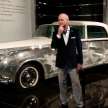
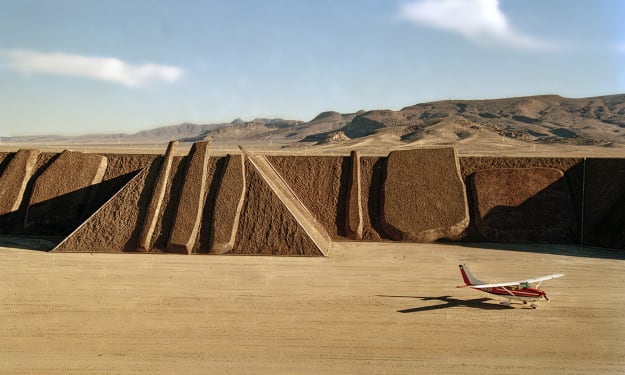



Comments
Jonathan Warren is not accepting comments at the moment
Want to show your support? Become a pledged subscriber or send them a one-off tip.